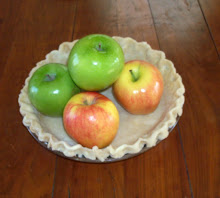What better way to start a lazy weekend morning than with a stack of pipping hot pancakes? For maximum effort, get dressed and head to the corner diner. Or throw on your sweatpants and head to the nearest drive-through. Next option is to stir up a mix at home. But why not go for easiest and tastiest? Just make 'em from scratch. All of the required ingredients are most likely sitting in your pantry.
Recipe
(from Betty Crocker's New Picture Cookbook, ©1961)
- ½ C plus 2 tablespoons all purpose flour
- ½ tablespoon sugar
- ½ teaspoon baking powder
- ¼ teaspoon baking soda
- ¼ teaspoon salt
- ½ egg, beaten (1 ½ tablespoons)
- ½ C plus 2 tablespoons buttermilk
- 1 tablespoon vegetable oil
Method
Let's start by talking about buttermilk, which is absolutely a required ingredient. If you happen to have some fresh buttermilk on hand, by all means use it. Most of you can make your own using the ratio of 1 tablespoon white vinegar with enough milk to make one cup, and let sit for 5-10 minutes until it clots. But I don't even keep milk on hand. For people like me and those who don't feel that the vinegar/milk option is quite as good as buttermilk, there's a better option. Due to bad experiences with powdered milk, I hesitated to try powdered buttermilk until recently. Turns out that I had nothing to fear because powdered buttermilk is excellent for baking. Unlike powdered milk, you don't mix it in advance. Just add the required amount of powder to the dry ingredients (to get ½ C plus 2 tablespoons milk, use 2 ½ tablespoons powder) and ½ C plus 2 tablespoons water to the wet ingredients.
The next challenge is adding ½ an egg. No big deal, the average large egg yields 3 tablespoons of liquid. Just measure out 1 ½ tablespoons of beaten egg, either discard the rest or make a side of ½ a scrambled egg.
Mix the dry ingredients in a small bowl and the wet ingredients in a larger bowl
Gradually add the flour mixture to the wet ingredient and whisk together. Don't over mix, but be sure to break up all of the flour clumps.
Heat a skillet to the point where a few drops of water sprinkled on the surface sizzles. Oh wait, that's for those of you who didn't just impulsively buy a new toy. It's time to meet Gertie the Griddle. Set the temperature to 375° for hotcakes.
I'm a little conflicted about Gertie: first of all, who names their kitchen equipment? And also, all that you should need to run a first rate home kitchen is a sharp knife and a cast iron skillet. But Gertie was the daily special on a certain discount site last week for a price that made me involuntarily click the buy button.
Regardless of whether you're using a stove top skillet or a cool new toy, lightly spray the surface with oil and measure out ¼ cup batter for each hotcake. Gertie has no problem handling four at a time, but don't try to compete if you're using a skillet. Really, even the largest skillet can only fit one hotcake at one time.
When the hotcakes are ready to turn, bubbles will form and the edges will thicken. On Gertie, this takes about 3 minutes, a bit longer on a skillet. You also can't really see the edges on a skillet.
Cook the 2nd side a few minutes more.
Shoot, I haven't made pancakes that looked this good since I worked at McDonald's in high school.
Add butter and syrup, and you're good to go.












No comments:
Post a Comment